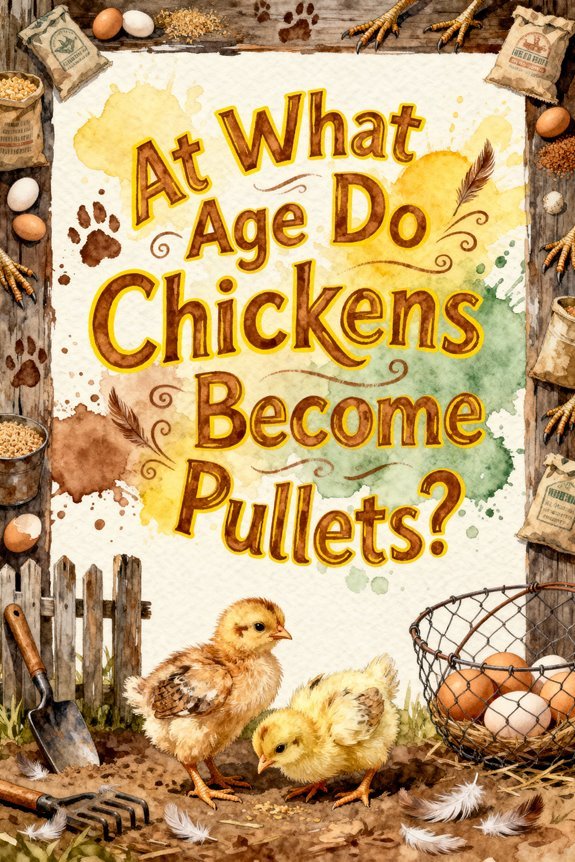At What Age Do Chickens Become Pullets?
Your chicken officially becomes a pullet at six weeks of age, marking the change from chick to pre-laying hen. During this phase, you’ll notice rapid physical changes including adult feather development, skeletal growth, and intensified social behaviors. The pullet stage continues until sexual maturity around 18-24 weeks, though timing varies by breed. Understanding these developmental stages helps you provide ideal nutrition and care throughout their journey to egg production.
The Journey From Chick to Pullet: Understanding Growth Stages
While the transformation from chick to pullet follows a predictable timeline, each stage represents distinct developmental milestones that require specific care and attention. You’ll observe your newly hatched chicks relying on supplemental heat as they develop their initial down feathers. During the first six weeks, chick behavior centers on basic survival skills – learning to eat, drink, and interact with flockmates.
At six weeks, you’ll notice significant feather development as your birds shift into the pullet stage. This period, lasting until six months of age, brings rapid physical changes and the emergence of breed-specific coloring. Your pullets will establish social hierarchies and begin displaying more complex behaviors. They’ll require adjusted nutrition through grower feeds to support their skeletal development as they prepare for eventual egg production. Around week sixteen, first eggs may appear as pullets transition into their productive laying phase.
Physical Changes During the Pullet Phase
As pullets progress through their developmental phase, they undergo dramatic physical transformations marked by rapid organ and tissue growth. You’ll notice their intestinal tract develops first, followed by intensive bone and muscle growth in the initial weeks. Their skeleton reaches 95% completion by week 13, while breast muscle development peaks between weeks 12-18. Proper nutrition during the first two weeks is especially critical for achieving optimal development outcomes.
Feather development advances steadily, with adult plumage established around 12 weeks. Hormonal changes trigger significant developments between weeks 14-19, as the reproductive tract matures and medullary bone formation begins. You’ll observe their combs and wattles enlarging and deepening in color as they approach sexual maturity. Their body size typically doubles between weeks 14-20, accompanied by distinctive behavioral changes like nest searching and squatting, signaling their approaching shift to laying hens.
Key Milestones in Pullet Development
The development of pullets follows distinct milestones that mark their progression from chicks to mature laying hens. You’ll observe your chicks enter the pullet stage at around 6 weeks, with rapid growth and organ development occurring in the first two weeks of this change. Between 6-12 weeks, you’ll notice the establishment of social hierarchies as pullets begin interacting more intensely with flockmates. During this stage, they’ll begin transitioning from chick crumbles to a proper layer feed to support their growing nutritional needs. Around week 16, pullets need higher calcium levels to prepare for their first egg production. As your pullets mature, ensure they have adequate coop space of 3-5 square feet per bird for optimal development.
Breed-Specific Timing and Variations
Different chicken breeds exhibit distinct timelines for reaching pullet stage and sexual maturity, with considerable variation between heritage and hybrid varieties. Breed characteristics strongly influence when your chickens become pullets, typically between 16 and 24 weeks of age. Hybrid breeds like ISA Browns mature faster, reaching pullet stage around 16-18 weeks, while heritage breeds such as Plymouth Rocks take closer to 24 weeks. Rhode Island Reds typically reach egg laying age at 18-20 weeks. Productive layers like Australorp chickens can begin producing eggs earlier than other heritage breeds.
Genetic influences play an essential role in determining maturation rates. You’ll notice commercial hybrids develop more quickly due to selective breeding for early egg production, while dual-purpose breeds mature more slowly. Environmental factors can modify these timelines – seasonal changes affect heritage breeds more markedly than hybrids, and your geographic location may impact development speeds within the same breed. Using colored leg bands can help track individual pullets’ ages and development within mixed breed flocks.
Nutrition and Care During the Transition Period
Managing nutrition during the shift from chick to pullet requires precise dietary adjustments to support sexual maturation and future egg production. You’ll need to implement strategic nutrient adjustments as protein levels decrease from 18-24% in starter feed to 16-18% in pullet feed, while maintaining steady growth rates without obesity.
Feed management involves moving through multiple phases: starter (0-6 weeks), grower (6-16 weeks), and layer feed (16-20 weeks). You’ll want to gradually blend feeds over 4-5 days to prevent digestive upset. During the shift, calcium levels must increase to at least 3.25% to support eggshell formation, while carefully balancing other minerals. Monitor your pullets’ daily feed intake of 100-105 grams to achieve the target mature weight of 1700-1800 grams, ensuring proper metabolic development for egg production. This careful nutrition management helps birds reach peak egg production around 32 weeks of age. Providing free-choice access to complete layer feeds ensures hens receive nearly all their required nutrients while maintaining consistent egg quality. Offering oyster shell supplements allows hens to self-regulate their calcium intake for optimal eggshell strength.




